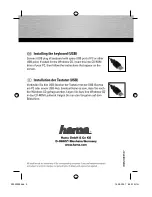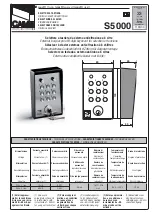
Program mode: HD-1
36
Wave Sequence Swing
Swing uses the Wave Sequence’s Resolution setting
Since the programmed rhythms of Tempo Wave
Sequences can vary widely, each has its own Swing
Resolution setting, from 1/32 note triplets to 1/4 note.
If the Program contains two or more Wave Sequences
with different Swing Resolution settings, the Program
will use the finest value. For example, if one is set to
1/8 and the other is set to 1/16, the Program will use
1/16 notes.
Key Sync
[On, Off]
On (checked):
When Key Sync is On, each note’s Wave
Sequence(s) will progress independently, so that each
one can be on a different step, or moving at a different
rate.
Off (unchecked):
When Key Sync is Off, all of the
Wave Sequences will be synchronized on the same
step. There is one exception to this, however: if
Duration is modulated with velocity or note-number,
the Wave Sequences can still progress at different rates.
Quantize Trigger
[On, Off]
This parameter applies only when the Program is
using one or more Wave Sequences set to Tempo mode.
It allows you to force most Tempo-mode Wave
Sequence note-ons to be in sync, making it easier to
play along with other rhythmic elements.
When Quantize Triggers is On, note-ons are quantized
to 8th notes using the current tempo reference. (See
below for a few more details.)
The tempo reference can come from different sources,
depending on the current mode, and whether or not
KARMA is on:
• In Program and Combi modes, if KARMA is off,
note-ons are synchronized with the sounding
Tempo-mode Wave Sequence, if any.
• In Program and Combi modes, if KARMA is on,
note-ons are synchronized with KARMA.
• In Sequencer mode during playback or recording,
note-ons are synchronized with the sequence.
• In Sequencer mode, while the sequencer is stopped,
note-ons are synchronized with RPPR and
KARMA.
On (checked):
Note-ons will be quantized.
Off (unchecked):
Note-ons will be played instantly,
the moment that you play the keyboard.
How Quantize Trigger works
The Quantize Trigger feature tries to make a good
guess at where you intended the note to be. If you play
the note just a bit late–within a 32nd note of the 8th
note–it will assume that you meant the note to sound
on the beat that just passed. In this case, the note will
play immediately.
On the other hand, if you play the note up to three
32nd notes early, it will assume that you’re intending
the note to sound on the next beat. In this case, the
note-on is delayed until the next 8th note.
1–1f: Half-Damper Control
A half-damper pedal is a special type of continuous
foot pedal, such as the Korg DS-1H. In comparison to a
standard footswitch, half-damper pedals offer more
subtle control of sustain, which can be especially useful
for piano sounds.
The OASYS will automatically sense when a half-
damper is connected to the rear-panel DAMPER input.
For proper operation, you will also need to calibrate
the pedal, using the Calibrate Half-Damper command
in the Global page menu.
The off and full-on positions of the half-damper work
just like a standard footswitch. In conjunction with the
Enable Half-Damper
parameter, below, intermediate
positions allow a graduated control of sustain, similar
to the damper pedal of an acoustic piano.
Enable Half-Damper
[On, Off]
When this is
On
(checked), Half-Damper pedals,
normal sustain pedals, and MIDI CC# 64 will all
modulate the Amp EG, as described below.
When this is
Off
(un-checked), the pedals and MIDI
CC#64 will still hold notes as usual, but will not
modulate the Amp EG.
Half-Damper Pedal and Release Time
The amount of modulation depends on whether the
Amp EG
Sustain Level
is set to
0
(as is the case with
most acoustic piano sounds), or set to
1
or more. The
modulation is continuous, from 1x (no change) to 55
times longer; the table below shows a selection of
representative points.
Half-Damper modulation of Amp EG Release Time
1–1g: Scale
Type [Equal Temperament…User Octave Scale15]
Selects the basic scale for the Program.
0%
Swing %
+100%
–100%
+200%
+300%
+300
Beat
1
Beat 2
Swing Resolution =
3
3
3
3
+100
–100
+200
CC#64
Value
Multiply Amp EG Release Time by…
If Sustain = 0
If Sustain = 1 or more
0
1x
1x
32
2.1x
2.1x
64
3.2x
3.2x
80
5.9x
96
22.3x
127
55x
Summary of Contents for Electronic Keyboard
Page 1: ...Parameter Guide Parameter Guide ...
Page 2: ......
Page 180: ...Program mode EXi 170 ...
Page 290: ...EXi STR 1 Plucked String 280 ...
Page 572: ...Sequencer mode 562 ...
Page 700: ...Global mode 690 ...
Page 751: ...Insert Effects IFX1 IFX12 Routing 741 Fig 2 3a Fig 2 3b ...
Page 902: ...Effect Guide 892 ...
















































